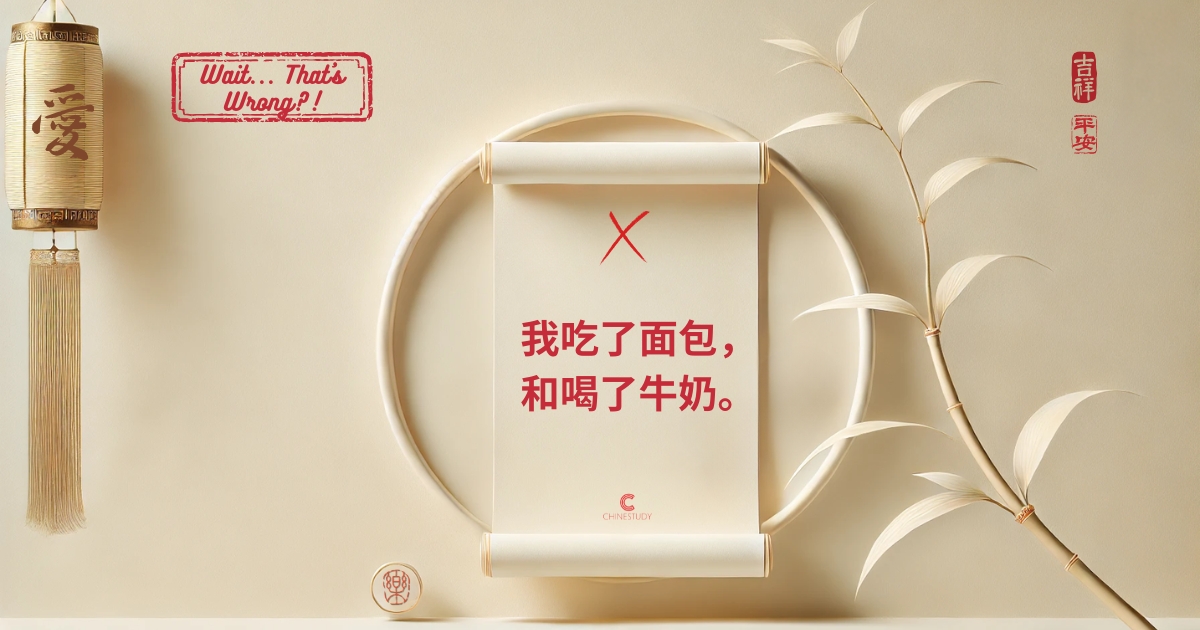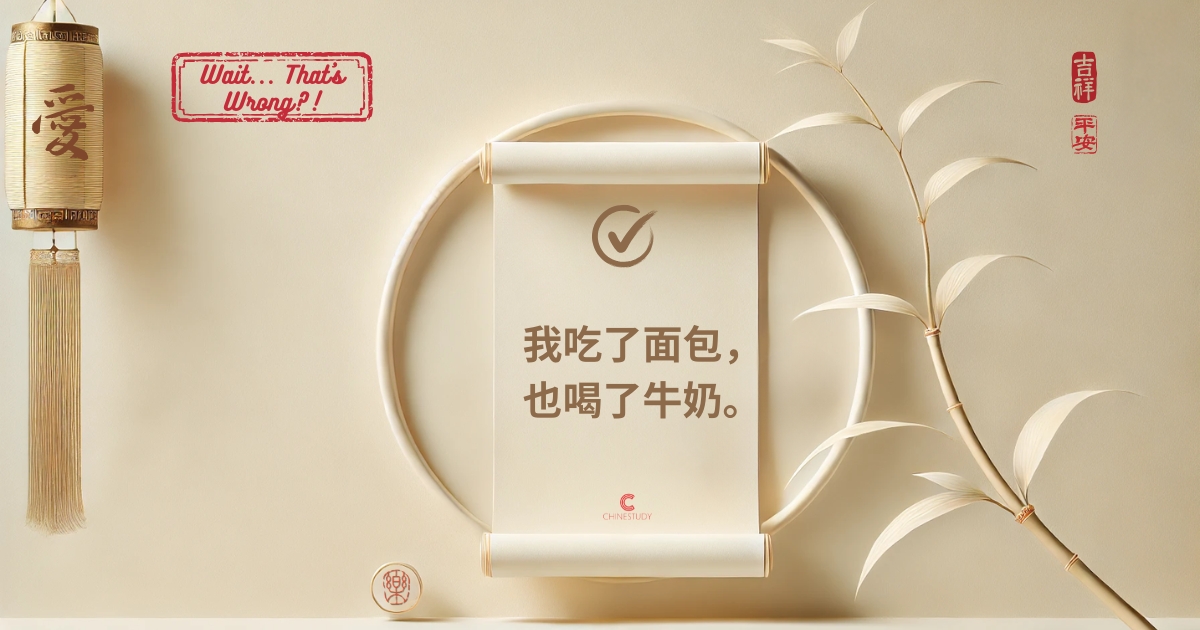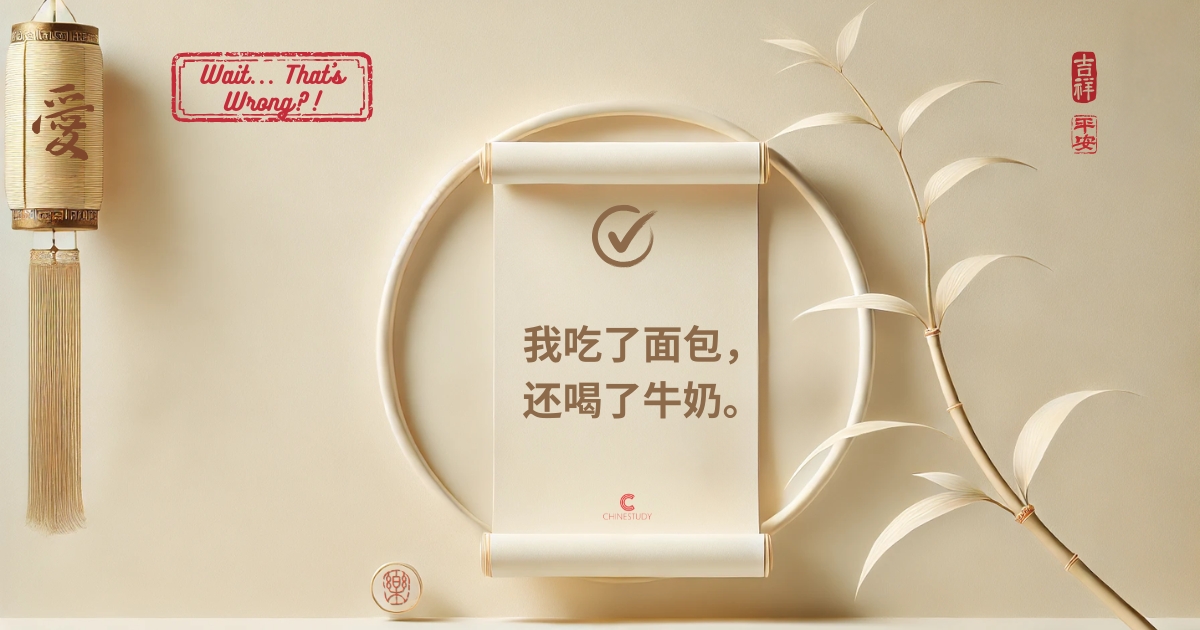|
Word |
Meaning |
Use when ... |
|---|---|---|
|
和 (hé) |
and |
Connect two nouns |
|
也 (yě) |
also, too |
Connect two equal actions |
|
还 (hái) |
also, in addition |
Add one more action |
😅 我吃了面包,和喝了牛奶?Wait… That’s Wrong?!

Have you ever said something like:
❌ 我吃了面包,和喝了牛奶。
(Wǒ chī le miànbāo, hé hē le niúnǎi.) – I ate bread and drank milk.
It sounds okay if you’re thinking in English… but in Chinese, it’s not natural and not correct.
Let’s fix it 👇
❌ What’s wrong?
In English, we connect actions with “and”, like:
“I ate bread and drank milk.”
But in Chinese, 和 (hé) is usually used to connect nouns, not verbs phrases.
So when you say:
❌ 我吃了面包,和喝了牛奶。
It sounds awkward because you’re using 和 to connect two verbs phrases, which isn’t how Chinese works.
🛠 Let’s Fix It
Wrong sentence:
❌ 我吃了面包,和喝了牛奶。Wǒ chī le miànbāo, hé hē le niúnǎi.
Correct sentence:
There are two better ways to say this:
1️⃣
- ✅ 我吃了面包,也喝了牛奶。
- Wǒ chī le miànbāo, yě hē le niúnǎi.
- 👉 I ate bread and also drank milk.

2️⃣
- ✅ 我吃了面包,还喝了牛奶。
- Wǒ chī le miànbāo, hái hē le niúnǎi.
- 👉 I ate bread and also drank milk.

❓ What’s the Difference Between 也 and 还?
🟢 也 (yě) - also, too
- Use when both actions are equally true.
- No strong time sequence.
🟢 还 (hái) - also, in addition
- Use when you want to add another thing or action — often something more than expected.
- Often used when the second thing feels like an extra step or bonus.
💬 More Examples
🗣 Let’s look at a couple more natural Chinese sentences:
1. 我买了水果,也买了面包。
- (Wǒ mǎi le shuǐguǒ, yě mǎi le miànbāo.)
- 👉 I bought fruit and also bought bread.
- 💡 Use 也 to show two equal actions.
2. 他学了汉语,还学了日语。
- (Tā xué le Hànyǔ, hái xué le Rìyǔ.)
- 👉 He studied Chinese and also studied Japanese.
- 💡 Use 还 to add another action that feels like “in addition.”
3. 我们去了商店,也去了公园。
- (Wǒmen qù le shāngdiàn, yě qù le gōngyuán.)
- 👉 We went to the store and also to the park.
- 💡 Use 也 again to connect two past actions.
4. 她写了作业,还看了书。
- (Tā xiě le zuòyè, hái kàn le shū.)
- 👉 She did her homework and also read a book.
- 💡 还 adds something extra to the first action.
📌 Easy Tip to Remember
- Use 和 (hé) to connect two nouns.
- Use 也 (yě) or 还 (hái) to connect two verb phrases.
🎯 Interactive Practice
Can you fix the wrong sentences below?
1. ❌ 他去了北京,和去了上海。
✅ Correct answer:
- 他去了北京,也去了上海。
- (Tā qù le Běijīng, yě qù le Shànghǎi.)
- 👉 He went to Beijing and also to Shanghai.
2. ❌ 我做了作业,和看了电视。
✅ Correct answer:
- 我做了作业,还看了电视。
- (Wǒ zuò le zuòyè, hái kàn le diànshì.)
- 👉 I did homework and also watched TV.
3. ✅ 我吃了米饭和蔬菜。
- (Wǒ chī le mǐfàn hé shūcài.)
- – I ate rice and vegetables.
- ✔ This is correct — 和 is used to connect nouns.
🚀 Final Reminder
Keep practicing, and your Chinese will sound smoother every day! 💪🙂
👉 Stay tuned for the next common mistake in this blog series!
Thank you for subscribing!
Have a great day!